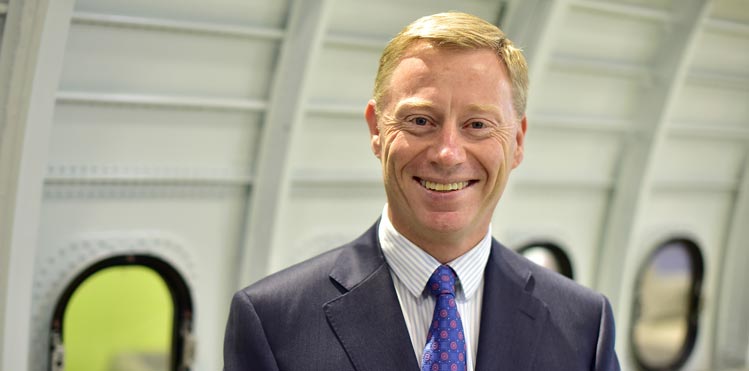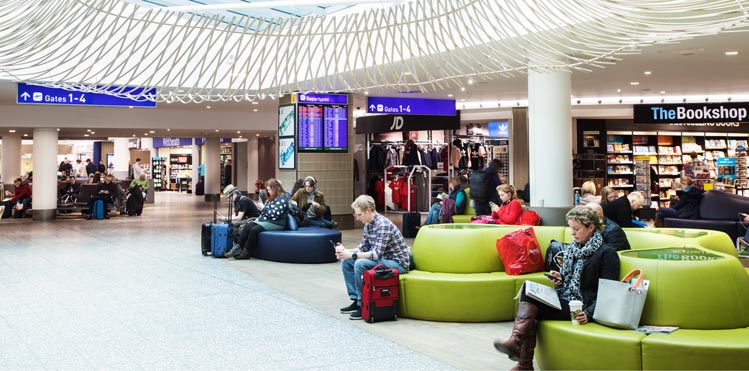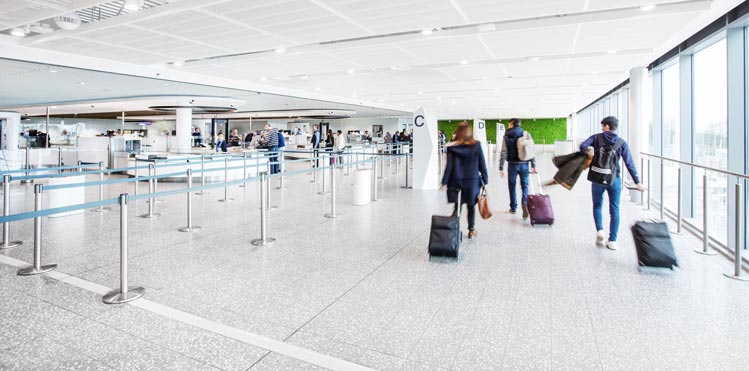Bristol Airport celebrates its 60th anniversary this year and is pursuing a progressive strategy to maintain the upward trend that has seen seven consecutive years of growth. Robert Sinclair, CEO Bristol Airport, discusses developments with Ross Falconer.

Robert Sinclair, CEO Bristol Airport: “We are on the record as saying that we believe Bristol should be the ‘next cab off the rank’ for long-haul services from the UK regions. Direct transatlantic flights have been successful before – with Continental Airlines between 2005 and 2010 – and are certainly high on our list of priorities, as is a Middle East service.”
The South West UK economy continues to prosper, with the region second only to London in terms of its contribution-per-head to the overall UK economy. This generates strong outbound business and leisure traffic – and with world-renowned attractions, such as Stonehenge and the World Heritage City of Bath, on its doorstep, the airport is also welcoming a growing number of international visitors.
“Add to this major events such as the Glastonbury Festival and the UEFA Champions League Final in Cardiff – both of which will generate significant additional traffic for us – and it is clear that 2017 is going to be a big year for Bristol Airport,” says Robert Sinclair, CEO Bristol Airport.
Indeed, it is a big year not least because of the 60th anniversary of operations on the current site, which was officially celebrated on 3 May. The airport brought together the old and the new, in the shape of a vintage DC-3 and an A319, which its largest carrier easyJet named Spirit of Bristol to mark the occasion. “It was fantastic to see these two aircraft, which both revolutionised commercial air travel in their time, line up alongside each other in front of our old terminal building from where operations began back in 1957,” Sinclair enthuses. “There have been so many highlights in our 60-year history, but, for me, the construction of the current terminal – which opened in 2000 – was an incredibly important development. It put us in a great position to attract the new generation of low-cost airlines, which have since revolutionised air travel and enabled regional airports to offer connectivity which would have been unthinkable outside major capital cities only a few years before.”
Continued upward trend in Q1 2017
Just 33,000 travellers used the airport in its first year – equivalent to a busy 24 hours today. Bristol is now England’s third-largest regional airport, with direct services to over 120 destinations in 30 countries.
2016 was another record year, and a seventh consecutive year of growth. The airport welcomed 7.5 million passengers in 2016 – an 11.3% increase on the previous year. Scheduled and charter traffic contributed to this increase, through a combination of new routes and increased frequency and capacity on existing services. The upward trend continued into the first quarter of 2017, and over eight million passengers are expected for the first time this year.

Robert Sinclair, CEO Bristol Airport: “We negotiate commercial deals with our airline partners which should ultimately see both parties benefit. We want to see sustainable growth through routes which add value for passengers who live in, visit or do business with our region.”
“We haven’t seen an impact from Brexit, but we are concerned that a lack of clarity on future air services agreements could impact airline decision-making over the next 12 months,” Sinclair explains.
Bristol Airport adopts a proactive partnership approach with airlines, through which it identifies mutually-beneficial route opportunities, which add value to the network and are sustainable over time. This has delivered tangible results. WOW air announced in March that it will begin services from Bristol to Chicago via Reykjavik on 13 July; on 20 May the airport welcomed the return of British Airways with four routes – Florence, Ibiza, Malaga and Palma de Mallorca; and Thomson Airways restarted flights to Cancún and Orlando Sanford on 6 May.
“We are on the record as saying that we believe Bristol should be the ‘next cab off the rank’ for long-haul services from the UK regions,” says Sinclair. “Direct transatlantic flights have been successful before – with Continental Airlines between 2005 and 2010 – and are certainly high on our list of priorities, as is a Middle East service. But we also see short-haul opportunities in Scandinavia, for example. We can tap into a wealth of regional data to support the business case for routes, and we will work with airline partners to evaluate options and provide marketing support. As passenger numbers increase and we continue to invest in high quality facilities, we believe airlines will want to have a presence in Bristol.”
Digital marketing is a real area of focus, and the airport is strengthening this function so it can amplify airlines’ route marketing campaigns through its own channels. Indeed, Bristol Airport is particularly proactive on social media, with over 43,000 ‘likes’ on Facebook and more than 16,000 followers on Twitter.
‘Sustainability central to our thinking’
Planning permission is already in place for development up to 10 million passengers per year, a milestone forecast to be achieved as soon as the start of the next decade, and the airport will be updating its master plan over the coming months.
“Now is the right time to start thinking about how we can continue to meet the growing demand for air travel to and from our region in future,” Sinclair comments. “We will be seeking the views of passengers, employees, neighbours and others, to help us shape our vision. We understand there will be challenges, but there is also a huge opportunity to create jobs and generate economic benefits for years to come, which we hope will be embraced by our stakeholders.”

Bristol Airport opened a £24 million (€28m) terminal extension in December 2016, with a state-of-the-art security screening area at the heart of the development.
A £2.3 million (€2.7m) upgrade of the immigration hall was completed earlier this year, enlarging and enhancing the passport control area and installing 10 of the latest ePassport gates. “As well as introducing this new equipment, we also redesigned the space to create a more welcoming environment and to streamline the border process for passengers,” Sinclair notes.
Work continues on a new reception centre in the airport’s Silver Zone, as part of a £20 million (€23m) investment across Bristol Airport’s car parks. There are also plans to refurbish the check-in hall, introducing some of the ‘sense of place’ design that has been central to recent developments. Meanwhile, additional aircraft stands are close to completion, so capacity is being added across the airfield and in the terminal.
Sustainability is at the heart of these developments. Bristol Airport is accredited at Level 1 Mapping of ACI’s Airport Carbon Accreditation, and is working towards Level 2 Reduction with the ultimate goal to become carbon neutral.
The South West region is home to a thriving low-carbon and renewable energy sector, and Bristol was the European Green Capital in 2015. Bristol Airport itself is located just outside the city in rural North Somerset, and the coast and countryside are central to its tourism offer. “We are sensitive to the environment in which we operate, and sustainability is central to our thinking as we turn our thoughts to the future,” says Sinclair. “In the meantime, initiatives such as our Airport Environmental Improvement Fund, which contributes more than £100,000 (€116,000) a year to local community projects and noise insulation for homes, are helping to mitigate the impacts of our operations today.”
Looking ahead, the airport is focused on maintaining its customer service standards through the busy summer season, and beyond the airport boundary there are plans to work with stakeholders to identify long-term surface access solutions. “And, working with colleagues in the industry, I will be urging Government in the UK and EU27 to prioritise aviation in Brexit negotiations,” Sinclair concludes.
Bristol Airport factbox
- 2016: 7.5 million passengers
- 2016 passenger traffic growth: 11.3%
- 2017 passenger traffic growth (Q1): 12.5%
- Key airline customers: Aer Lingus Regional, Aurigny, flybe, bmi regional, British Airways, Brussels Airlines, easyJet, KLM, Ryanair, Thomson, Thomas Cook, Wizz Air, WOW air
- Number of routes: 120
- Top 3 destinations: Dublin, Amsterdam, Edinburgh







